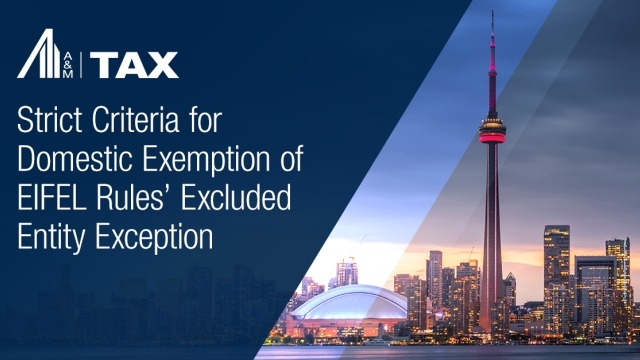The New Dispute Resolution Panel: A Ray of Hope for Indian Taxpayers
The last 12 months have seen many important changes and proposed changes to transfer pricing regulations in India. While some of them have been introduced in the Union Budget of India, others have been a part of a bigger overhaul of the Indian tax system via the new Direct Tax Code (DTC). This article focuses on the key elements of the new dispute resolution process and the practical impact of this dispute resolution process from an Indian and U.S. perspective.
Recent years have been tough on multinational corporations operating in India on three counts: income characterization (withholding tax of royalties and fees for technical services), permanent establishment issues and transfer pricing. While the challenges facing multinational corporations have been significant, there seems to be an acknowledgement by the Indian government that foreign investment is extremely sensitive to prolonged uncertainty in tax-related matters.
Because of the increasing perception that India had become (from a tax perspective) a hostile environment for foreign investors, capital has become scarce during the last 12 to 18 months. In response to this, Indian authorities have proposed path-breaking changes to restore faith in the Indian tax and regulatory system. As a result, Budget 2009 proposed setting up a dispute resolution panel (DRP) for foreign companies and Indian residents for the resolution of transfer pricing disputes.
Before delving into what the new DRP implies for taxpayers, here are its key features:
- The DRP consists of three commissioners or directors of income tax appointed by the Central Board of Direct Taxes (CBDT).
- It has wide-ranging powers akin to those of a court under the Code of Civil Procedure, 1908.
- Taxpayers with transfer pricing adjustments or a foreign company can apply to the DRP.
- Tax officers are required to share the draft results of an audit with a taxpayer, who can then apply to the DRP before the final results are issued.
- On receipt of the draft results of an audit, the taxpayer must file its acceptance (with the tax officer) or objections (with the tax officer and the DRP) within 30 days.
- In case of acceptance or no objections being received within 30 days, the tax officer must issue the final results of the audit within one month from the end of the relevant month.
- If an objection is filed, the DRP will be required to analyze the case and give directions to the tax officer to complete the audit.
- The DRP must examine all the relevant facts and submissions.
- The DRP can also call for additional evidence and analysis and can confirm, reduce or even enhance the proposed adjustment.
- The directions issued by the DRP are binding on the tax officer.
- The DRP must provide an opportunity of being heard to either the taxpayer or the tax officer whose interest is prejudiced by the directions being given.
- The DRP has a time limit of nine months (from the end of the month in which the draft order is forwarded to the taxpayer) to issue its directions.
- Appeal against such an order will lie only with the Income Tax Appellate Tribunal (and thereafter to the respective state-level High Court and Supreme Court).
- Cases pending adjudication on or after October 1, 2009, can approach the DRP, subject to the conditions mentioned above.
This diagram provides an overview of the domestic audit and litigation procedure:
Appeal to the High Court and the Supreme Court is possible only where there is a substantial question of law.
The DRP is a positive step toward ensuring faster resolutions of transfer pricing and other international tax-related disputes. The timelines indicate a clear intent to fast-track such controversies and, at the same time, protect foreign companies from audits and the resulting tax demands. Given that commissioner appeal proceedings typically take around 24 to 36 months to complete, by opting for DRP, a taxpayer can look at saving at least 12 to 24 months for its case.
To start with, the DRP has been constituted only in select cities: Ahmedabad, Pune, Mumbai, Chennai, Kolkata, Delhi, Bangalore and Hyderabad. Further, since the number of disputes is disproportionately higher in Delhi and Mumbai, two DRPs will operate in each of these cities simultaneously.
Questions are already being raised about how well and how independently the DRP will operate. Answering these questions would require a fair bit of crystal ball gazing, so the thought process of taxpayers should focus on how best to use this forum for a meaningful outcome. One strategic advantage that taxpayers will now have is that they will be fully aware of what the tax officer intends to do and how. One might argue that such a right already exists, since the tax officer needs to provide a final opportunity to the taxpayer before carrying out an adjustment. This, however, is not the case in a majority of the cases at the field level. The final notice (called the “show cause” notice) normally is very broad and vague. The tax officer usually documents what is incorrect in the taxpayer’s approach rather than proposing the correct approach in detail. The result is that transfer pricing adjustments are usually a shock to the taxpayer.
It will be important for taxpayers to reassess existing transfer pricing documentation in order to capitalize on the opportunity to challenge results of audits and to avoid potential pitfalls inherent in this new system. The rapid nine-month review by the DRP also increases the value of being prepared in advance with robust economic analyses. Such a review would mean not only scouting for new comparables but also refining or enhancing theoretical arguments, improving or changing transfer pricing methodologies and providing supporting analyses when possible.
Improved documentation does not guarantee a successful outcome with the DRP, particularly since the DRP’s task is to review what has already happened and not to re-hear the whole case anew. However, since the DRP is required to consider facts and analyses presented by the taxpayer as well as the tax authority, the new system increases the value of thorough documentation using rigorous economic analyses. Most of the documentations prepared today are based on one-sided analysis with little or no focus on the transaction dynamics. This may just be a wake-up call for taxpayers to look at transfer pricing documentation as a strategic investment rather than a compliance cost.
Also, many U.S. companies are now contemplating or already pursuing competent authorities for resolution of transfer pricing disputes. This may require an overhaul of the existing documentation, and thus embarking on this at the time of the DRP may just mean better preparedness for competent authority proceedings. Of course, there may be utility at the tax tribunal also (depending where one choose to go), given the fact that under the existing framework, a taxpayer can opt for a competent authority resolution and domestic appeal simultaneously.
An important point to note is that while the Indian tax treaties typically provide for the scenario wherein a taxpayer can apply for competent authority settlement of transfer pricing adjustments, the Indian competent authority has been reluctant to admit cases where the final order has not yet been issued. This may imply that, going forward, in cases where the taxpayer has applied to the DRP for a review, there may be issues with the admissibility of the review with the Indian competent authority until the final audit results are issued.
Post-2011, the scenario looks to be even more interesting, with advance pricing arrangements (APAs) proposed to be introduced in India. While there is still limited visibility, it appears the Indian APAs may prove to be similar to the U.S. program and hence may call for another dimension to be added to transfer pricing documentation. While the DTC provides for only unilateral APAs, we believe that with the existing tax treaty text, a taxpayer would be able to link transfer pricing documentation with the competent authority and look at a broader resolution in both countries.
Another benefit of the DRP (though short term) is limited stay to the tax demand. This is because the tax demand (pursuant to a transfer pricing adjustment) can be raised only once the final order is issued. In a DRP scenario, since the draft order itself is challenged, the taxpayer will get a review (which will be equivalent to a first-level appeal) without being haunted for taxes. Similarly, penalties pursuant to adjustments would also be levied once the final order is out. However, this is usually not material, as in most cases, Revenue authorities are kind enough to put penalties in abeyance until the final disposition of the case.
The efficacy of this panel will depend on the mindset of its members and whether they are likely to be able to review the tax officer’s draft order as an independent body or whether their conduct is likely to be pro-Revenue. Further, the DRP is a dispute resolution body that can be approached post-filing of the tax return. There are several disputes at withholding tax stage (including withholding tax applicability on the sale of offshore company shares with the underlying Indian businesses) which remain unaddressed and for which there does not seem to be an appropriate dispute resolution body yet.
We are already seeing the first wave of notices from the DRP, with the first round of hearings to start very soon. For now, what is installed at the DRP is anyone’s guess...
Alvarez & Marsal Taxand Says:
Indian policy-makers have taken a positive step to making the lives of multinational corporations operating in India easier. It is now up to the taxpayers to latch onto this opportunity and make the best of it. While the intent is right, it is for all to wait and see how well the DRP will be executed. In the preface to his Budget speech for 2009–10, Finance Minister Pranab Mukherjee said, “While we are determined to convert our words into deeds, Members would appreciate that a single Budget speech cannot solve all our problems, nor is the Union Budget the only instrument to do so. Yet, it is an important means to share the vision of the Government, particularly as we begin a new term. I propose to do just that.”
Footnotes
ORDER NO 1/FT&TR/2010 issued by CBDT
Interestingly, in some of the cities the director of international tax (who is the supervisor) to the transfer pricing officer is a part of the DRP.
Authors
Sanjiv Malhotra
Director, BMR & Associates
(+91) 11-3081-5075
Email
For More Information on this Topic, Contact:
Laurie Dicker
Managing Director, Washington, D.C.
703-852-5015
|
Abhishek Goenka
Partner, BMR & Associates
(+91) 80-4032-0100
Email
Albert Liguori
Managing Director, New York
212-763-1638
|
Other Related Issues:
| 10/13/09 | |
| 08/23/07 |
Feedback:
We would like to hear from you.
Disclaimer
As provided in Treasury Department Circular 230, this publication is not intended or written by Alvarez & Marsal Taxand, LLC, (or any Taxand member firm) to be used, and cannot be used, by a client or any other person or entity for the purpose of avoiding tax penalties that may be imposed on any taxpayer.
The information contained herein is of a general nature and based on authorities that are subject to change. Readers are reminded that they should not consider this publication to be a recommendation to undertake any tax position, nor consider the information contained herein to be complete. Before any item or treatment is reported or excluded from reporting on tax returns, financial statements or any other document, for any reason, readers should thoroughly evaluate their specific facts and circumstances, and obtain the advice and assistance of qualified tax advisors. The information reported in this publication may not continue to apply to a reader's situation as a result of changing laws and associated authoritative literature, and readers are reminded to consult with their tax or other professional advisors before determining if any information contained herein remains applicable to their facts and circumstances.
About Alvarez & Marsal Taxand
Alvarez & Marsal Taxand, an affiliate of Alvarez & Marsal (A&M), a leading global professional services firm, is an independent tax group made up of experienced tax professionals dedicated to providing customized tax advice to clients and investors across a broad range of industries. Its professionals extend A&M's commitment to offering clients a choice in advisors who are free from audit-based conflicts of interest, and bring an unyielding commitment to delivering responsive client service. A&M Taxand has offices in major metropolitan markets throughout the U.S., and serves the U.K. from its base in London.
Alvarez & Marsal Taxand is a founding member of Taxand, the first global network of independent tax advisors that provides multinational companies with the premier alternative to Big Four audit firms. Formed in 2005 by a small group of highly respected tax firms, Taxand has grown to more than 2,000 tax professionals, including 300 international partners based in nearly 50 countries.
To learn more, visit www.alvarezandmarsal.com or www.taxand.com.
© Copyright 2010 Alvarez & Marsal Holdings, LLC. All Rights Reserved.
Alvarez & Marsal | 6th Floor | 600 Lexington Avenue | New York | NY | 10022




